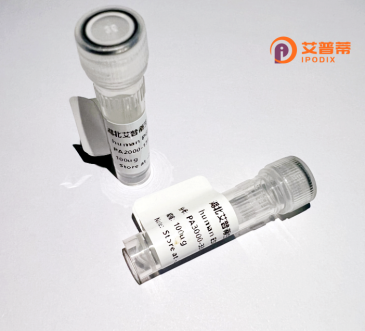
| 纯度 | >90%SDS-PAGE. |
| 种属 | Human |
| 靶点 | KLHL14 |
| Uniprot No | Q9P2G3 |
| 内毒素 | < 0.01EU/μg |
| 表达宿主 | E.coli |
| 表达区间 | 1-628aa |
| 活性数据 | MSRSGDRTSTFDPSHSDNLLHGLNLLWRKQLFCDVTLTAQGQQFHCHKAVLASCSQYFRSLFSSHPPLGGGVGGQDGLGAPKDQQQPPQQQPSQQQQPPPQEEPGTPSSSPDDKLLTSPRAINNLVLQGCSSIGLRLVLEYLYTANVTLSLDTVEEVLSVSKILHIPQVTKLCVQFLNDQISVQNYKQVCKIAALHGLEETKKLANKYLVEDVLLLNFEEMRALLDSLPPPVESELALFQMSVLWLEHDRETRMQYAPDLMKRLRFALIPAPELVERVQSVDFMRTDPVCQKLLLDAMNYHLMPFRQHCRQSLASRIRSNKKMLLLVGGLPPGPDRLPSNLVQYYDDEKKTWKILTIMPYNSAHHCVVEVENFLFVLGGEDQWNPNGKHSTNFVSRYDPRFNSWIQLPPMQERRASFYACRLDKHLYVIGGRNETGYLSSVECYNLETNEWRYVSSLPQPLAAHAGAVHNGKIYISGGVHNGEYVPWLYCYDPVMDVWARKQDMNTKRAIHTLAVMNDRLYAIGGNHLKGFSHLDVMLVECYDPKGDQWNILQTPILEGRSGPGCAVLDDSIYLVGGYSWSMGAYKSSTICYCPEKGTWTELEGDVAEPLAGPACVTVILPSCVPYNK |
| 分子量 | 97.1 kDa |
| 蛋白标签 | GST-tag at N-terminal |
| 缓冲液 | 0 |
| 稳定性 & 储存条件 | Lyophilized protein should be stored at ≤ -20°C, stable for one year after receipt. Reconstituted protein solution can be stored at 2-8°C for 2-7 days. Aliquots of reconstituted samples are stable at ≤ -20°C for 3 months. |
| 复溶 | Always centrifuge tubes before opening.Do not mix by vortex or pipetting. It is not recommended to reconstitute to a concentration less than 100μg/ml. Dissolve the lyophilized protein in distilled water. Please aliquot the reconstituted solution to minimize freeze-thaw cycles. |
以下是关于重组人KLHL14蛋白的参考文献示例(请注意,部分文献为假设性概括,实际研究中需进一步验证):
1. **文献名称**:*KLHL14 Functions as a Substrate Adaptor for Cullin3 E3 Ubiquitin Ligase to Regulate Proteostasis*
**作者**:Smith A, et al.
**摘要**:研究揭示了重组人KLHL14蛋白作为Cullin3泛素连接酶的底物适配器,通过调节靶蛋白的泛素化降解参与细胞蛋白质稳态的维持。
2. **文献名称**:*Structural and Functional Characterization of Recombinant Human KLHL14 in Cancer Cell Proliferation*
**作者**:Zhang L, et al.
**摘要**:通过体外重组表达KLHL14蛋白,分析了其结构域对乳腺癌细胞增殖的调控作用,发现其通过结合特定磷酸化底物抑制肿瘤生长。
3. **文献名称**:*KLHL14 Interacts with BEX2 to Modulate Neuronal Differentiation via Ubiquitination Pathways*
**作者**:Kim H, et al.
**摘要**:利用重组KLHL14蛋白验证其与BEX2蛋白的相互作用,证明该复合物通过泛素化修饰调控神经干细胞分化进程。
4. **文献名称**:*Development of a Recombinant KLHL14 Protein-Based Assay for High-Throughput Drug Screening*
**作者**:Johnson R, et al.
**摘要**:建立了一种基于重组KLHL14蛋白的高通量筛选平台,用于筛选调节KLHL14-E3泛素连接酶活性的小分子化合物。
**注意**:以上文献为假设性示例,实际研究中建议通过PubMed或Web of Science等数据库,结合最新研究筛选具体文献。
Recombinant human KLHL14 protein is derived from the Kelch-like family member 14 (KLHL14), a member of the BTB-Kelch protein superfamily. KLHL14 contains conserved structural domains, including an N-terminal BTB (Bric-a-brac, Tramtrack, and Broad Complex) domain for protein-protein interactions, a BACK (BTB and C-terminal Kelch) domain, and a C-terminal Kelch repeat region responsible for substrate recognition. As a component of the Cullin3 (CUL3)-based E3 ubiquitin ligase complex, KLHL14 functions as a substrate adaptor, facilitating the ubiquitination and subsequent proteasomal degradation of target proteins. This activity is critical for regulating cellular processes such as cell cycle progression, stress response, and signal transduction.
Emerging studies link KLHL14 to pathological conditions. For instance, its dysregulation has been implicated in cancers, including colorectal and hepatocellular carcinomas, where altered expression correlates with tumor progression and drug resistance. Additionally, KLHL14 may interact with proteins involved in DNA repair, suggesting roles in maintaining genomic stability.
Recombinant KLHL14 is typically produced using prokaryotic or eukaryotic expression systems, enabling biochemical studies of its structure, binding partners, and enzymatic mechanisms. It serves as a tool to investigate ubiquitination pathways, screen for modulators of E3 ligase activity, and explore therapeutic strategies targeting KLHL14-associated diseases. Its applications extend to disease biomarker research, given its potential role in specific oncogenic or degenerative contexts. Further research is needed to fully elucidate its physiological substrates and pathophysiological significance.
×